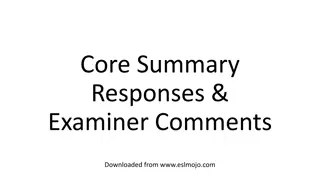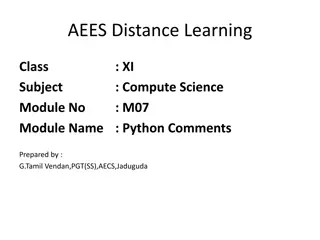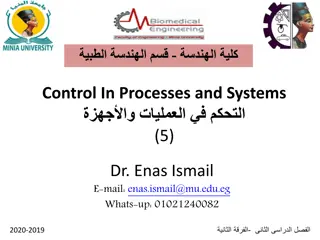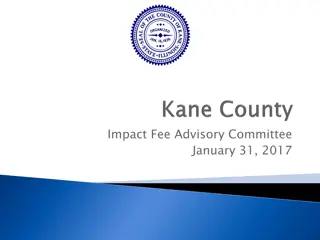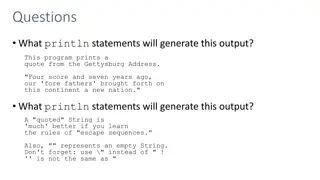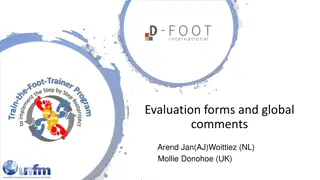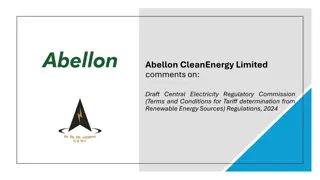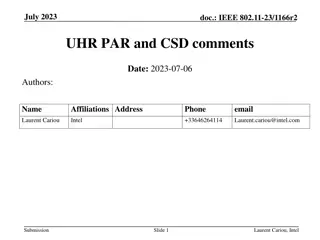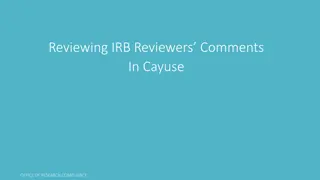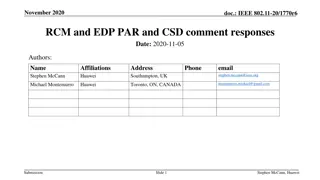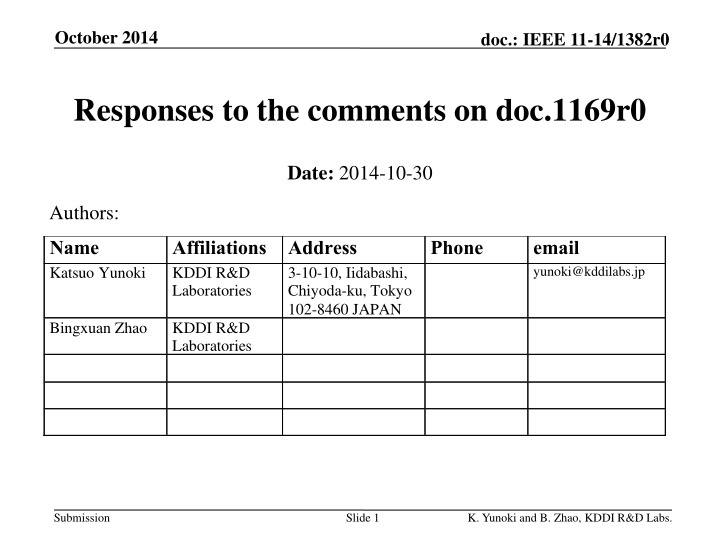
IEEE 11-14/1382r0 Responses to Comments and Proposals on DL-FDMA Considerations
This document from October 2014 addresses feedback and proposals related to DL-FDMA considerations for simultaneous data transmissions using multi-channels, focusing on access efficiency and interference mitigation in wireless communications. The content discusses the distinction between FDM and FDMA, varying frame lengths for receivers, legacy device considerations, and more.
Download Presentation

Please find below an Image/Link to download the presentation.
The content on the website is provided AS IS for your information and personal use only. It may not be sold, licensed, or shared on other websites without obtaining consent from the author. If you encounter any issues during the download, it is possible that the publisher has removed the file from their server.
You are allowed to download the files provided on this website for personal or commercial use, subject to the condition that they are used lawfully. All files are the property of their respective owners.
The content on the website is provided AS IS for your information and personal use only. It may not be sold, licensed, or shared on other websites without obtaining consent from the author.
E N D
Presentation Transcript
October 2014 doc.: IEEE 11-14/1382r0 Responses to the comments on doc.1169r0 Date: 2014-10-30 Authors: Name Katsuo Yunoki Affiliations Address KDDI R&D Laboratories Phone email yunoki@kddilabs.jp 3-10-10, Iidabashi, Chiyoda-ku, Tokyo 102-8460 JAPAN Bingxuan Zhao KDDI R&D Laboratories Submission Slide 1 K. Yunoki and B. Zhao, KDDI R&D Labs.
October 2014 doc.: IEEE 11-14/1382r0 Abstract This contribution is a follow-up of IEEE 11-14/1169r0, DL-FDMA considerations which was presented at September 2014 meeting. Submission Slide 2 K. Yunoki and B. Zhao, KDDI R&D Labs.
October 2014 doc.: IEEE 11-14/1382r0 Recap: DL-FDMA Simultaneous data transmissions to multiple STAs using multi-channels. It may improve access efficiency. DIFS + CW SIFS Ex. CCA Data to STA-1 AP STA-1 CH36 t ACK CCA Data to STA-2 AP STA-2 t CH40 ACK CCA Data to STA-3 AP STA-3 CH44 t ACK CCA Data to STA-4 AP STA-4 CH48 t ACK Submission Slide 3 K. Yunoki and B. Zhao, KDDI R&D Labs.
October 2014 doc.: IEEE 11-14/1382r0 Comments at September meeting C1: This proposal is Frequency Division Multiplexing (FDM), it s not FDMA. C2: Frame lengths are different for each receiver regarding data size to be sent and data rate. C3: It is necessary to consider interference mitigation measure for a legacy device at the mixed simultaneous transmission with 11ac devices. C4: Definition of legacy is needed. Submission Slide 4 K. Yunoki and B. Zhao, KDDI R&D Labs.
October 2014 doc.: IEEE 11-14/1382r0 C1: This proposal is Frequency Division Multiplex. A1: I m not sure if this access method can be called FDMA. However, each channel isn t dedicated to just a certain STA. Colors don t have any meanings. Just identifying different destinations. DIFS+CW Ex. to STA5 to STA1 to STA9 CH36 t ACK ACK ACK to STA6 to STA10 to STA2 t CH40 ACK ACK ACK to STA7 to STA3 to STA11 CH44 t ACK ACK ACK to to STA4 to STA8 CH48 STA12 t ACK ACK ACK Submission Slide 5 K. Yunoki and B. Zhao, KDDI R&D Labs.
October 2014 doc.: IEEE 11-14/1382r0 C2: Frame lengths are different for each receiver. A2: Yes. It s true. Similar size packets can easily be sent simultaneously. They will be small size packets. Time length difference among these packets will be adjusted by padding. DIFS+CW SIFS Ex. to STA1 pad t ACK to STA2 t ACK to STA3 pad t ACK to STA4 pad t ACK Submission Slide 6 K. Yunoki and B. Zhao, KDDI R&D Labs.
October 2014 doc.: IEEE 11-14/1382r0 C3: Interference mitigation is needed for legacy device. A3: Guard band can be set as a solution when simultaneous transmissions are needed for a legacy device. When the legacy uses 40MHzBW, When the legacy uses 20MHzBW, DIFS+CW SIFS DIFS+CW SIFS to STA1 (11a) Primary 20MHz Primary 20MHz t t ACK ACK to STA1 (11n) Guard band (not used) Secondary 20MHz Secondary 20MHz t t Guard band (not used) to STA2 (11ax) t t ACK to STA3 (11ax) to STA2 (11ax) t t ACK ACK Submission Slide 7 K. Yunoki and B. Zhao, KDDI R&D Labs.
October 2014 doc.: IEEE 11-14/1382r0 C4: Definition of legacy device is needed. A4: Legacy means the existing standards as follows: 2.4GHz 11b/g/n 5GHz 11a/g/n/ac Submission Slide 8 K. Yunoki and B. Zhao, KDDI R&D Labs.
October 2014 doc.: IEEE 11-14/1382r0 Summary This contribution responded to some comments received at September meeting. Comparing with OFDMA, the proposed access method may not have much better efficiency. However it doesn t require any negotiation processes before data frame transmissions. It will have advantages to deliver short packets to multiple destinations. Submission Slide 9 K. Yunoki and B. Zhao, KDDI R&D Labs.
October 2014 doc.: IEEE 11-14/1382r0 Straw poll Do you support to study this access method proposed in doc. 14/1169r0 and this contribution as a possible technique for efficiency improvement for 11ax? Y/N/A Submission Slide 10 K. Yunoki and B. Zhao, KDDI R&D Labs.
October 2014 doc.: IEEE 11-14/1382r0 References [1] IEEE 11-14/855r0, Techniques for Short Downlink Frames [2] IEEE 11-14/1169r0, DL-FDMA considerations Submission Slide 11 K. Yunoki and B. Zhao, KDDI R&D Labs.




